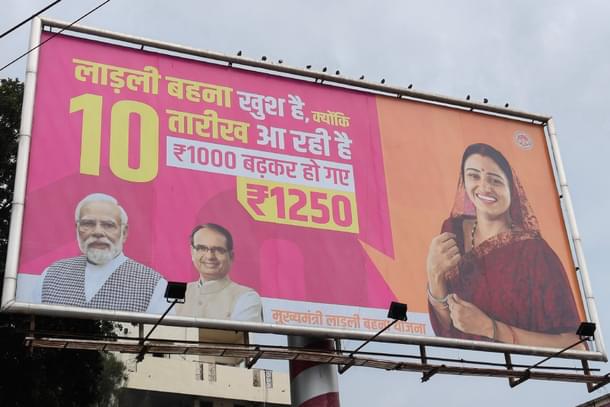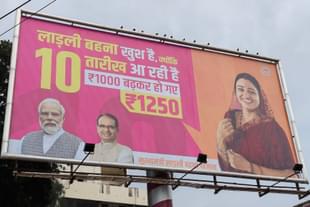Politics
The Year That Was In Politics - Since 4 June
Arush Tandon
Dec 31, 2024, 07:23 PM | Updated Jan 03, 2025, 11:15 AM IST
Save & read from anywhere!
Bookmark stories for easy access on any device or the Swarajya app.


Looking at the past year, 4 June stands as a watershed. It shattered many assumptions while forcing people to recall forgotten ones. But if on the 4th of June, observers of Indian politics were asked to describe how the political field of play would look on 31 December, 2024, it is unlikely that they would have predicted the current scenario.
If 4 June was a shock event, 8 October and 23 November were too.
Here thus, are four broad takeaways from Indian politics of the last six months. Note that this piece focusses largely on the Bharatiya Janata Party. This is primarily because of its position in Indian politics and also for the sake of brevity.
1. Handout schemes will headline 2024 in history
Caste has always been a leitmotif of independent India’s politics. In some years it is more prominent than in others but it is always there. We would gain nothing by saying that ‘2024 was the year when caste determined the direction of Indian politics’. Besides, there is a contender for the political theme of the year–handout schemes.
Handout schemes almost resembling universal basic income were either implemented or promised in every Assembly election that was conducted this year–from Haryana to Jharkhand and Maharashtra. The idea caught public attention in early 2023 when Congress secured a majority in Karnataka on the back of its ‘guarantees’. Following this, Shivraj Singh Chouhan in Madhya Pradesh (as incumbent) and the Bharatiya Janata Party in Chhattisgarh (as Opposition) came up with their own versions of handout schemes focussed on women and defied expectations with massive victories in their respective Assembly elections in the winter of 2023.
Come the 2024 Lok Sabha elections and Rahul Gandhi came up with the idea of ‘khatakhat’ schemes. ‘Khatakhat’ being a reference to the mechanical swiftness with which Gandhi claimed that a Congress government would put money in people’s accounts under the promised schemes.
On the other side, Narendra Modi did not promise any handout schemes over and above the welfare schemes already active. He ran a fiscally tight ship for the previous ten years and sought to beat a two-term anti-incumbency on the basis of his performance.
He is back in power but with the BJP falling below the majority mark. It was thus on the evening of 4 June that many, including this writer, realised the hold that handouts, or the promise of them, had over the public consciousness.
Since then however, it appears that the BJP has figured out how to beat the Congress at its own game. Take just one example, even though it be anecdotal: till around July-August 2024, handout schemes were commonly being referred to by the Rahul Gandhi terminology–khatakhat schemes. July 2024 saw the disbursement of the first installment of the Ladki Bahin Yojana in Maharashtra. Since then, the go-to phrase in common parlance for such schemes has become ‘ladli behna’, borrowing from Shivraj Singh Chouhan’s programme in MP.
These handout schemes are here to stay, at least in the short run until their burden starts to affect state governments’ finances beyond the threshold of endurance. The question is how does the BJP—the natural party of governance in India today—integrate these schemes into a sustainable governance model. A good place to look for signals (from the government, not party) might be the upcoming Economic Survey of FY2025.
Another event to watch out for would be the outcome of the Delhi Assembly election where the Aam Aadmi Party, facing strong anti-incumbency, is seeking to saturate the narrative with its promise of Rs 2,100 to every woman in Delhi every month.
The current term of the AAP government in Delhi has been particularly notorious and as a state Delhi is near the peak when it comes to per capita income. If AAP’s promise of Rs 2,100 cash handouts wins them the election even in such a context, then we have a more stubborn issue on our hands than we think.
2. ‘Batenge toh Katenge’
The ‘shock’ of 4 June for the BJP derived almost all its shock value from the results in Uttar Pradesh where the party slipped from 62 seats to 37. Post-facto analyses cited the shifting away of the votes of the Dalits and other ‘backward’ communities as the reason for the debacle.
And why did these votes shift? The explanation given for the shift is that these communities were spooked, or were made to feel spooked, by the BJP’s motto of ‘400 paar’. The narrative of the Opposition was that with a crushing majority in the Parliament, the BJP would ‘change’ the Constitution with ‘change the Constitution’ being a euphemism for doing away with caste-based reservations.
Regardless of the veracity of the claim, this narrative fractured the multi-caste coalition that the BJP had painstakingly stitched and kept together in Uttar Pradesh since 2014.
The question after 4 June was–how will the party advocating supra-caste unity respond to the challenge of caste?
One answer was suggested by UP chief minister Yogi Adityanath in Agra on the occasion of Janmashtami, which was on 26 August this year. ‘Batenge toh katenge’ he said. ‘If divided, we’ll be hacked down’.
The Prime Minister gave the slogan a more refined form but it was Yogi Adityanath’s original which got stuck in public memory. It’s not difficult to see why. In merely three words, ‘batenge toh katenge’ clearly states the mistake to avoid (batenge) as well as its dire consequence (katenge).
In the Assembly elections that followed, results suggested that the approach worked for the BJP. It should also be noted however that the Congress’ ‘Samvidhaan bachao’ (save the Constitution) would have gained little traction in an Assembly election anyway.
On the other hand, one explanation for the Haryana and Maharashtra results that this writer is unwilling to ignore is the ‘guilt’ explanation. It is this: during the Lok Sabha election, voters vented out their real and imagined frustrations with Modi. But once they had vented, they saw the consequence of their outburst—a Modi government dependent on allies.
In the background to all of this, they also saw what was happening in Bangladesh and the fate that befell Bangladeshi Hindus. Add to this the Islamist assertion on the streets in many corners of the country after 4 June. It is not difficult to see why many voters may have been struck by pangs of guilt and when the Assembly elections came, sought to redeem themselves.
3. Ceteris paribus, organisation wins
The trajectory of politics in 2024 reinforced the criticality of the party organisation, with one addendum—the motivations of the party organisation are equally important.
It was not as if the BJP developed a larger cadre base in Haryana and Maharashtra in the six months between Lok Sabha and Vidhan Sabha elections. But the spirit that enthused the cadre base was different. The Lok Sabha setback brought about an almost paranoid obsession with getting every last detail right about the elections. While results of Haryana, and more so Maharashtra, elections may suggest a statewide wave, the truth is that such a wave was constructed constituency-by-constituency by the organisation.
That was also likely the main difference between the Jharkhand and Maharashtra results for the BJP. Swarajya’s Abhishek Kumar, who covered the tribal-dominated seats of Jharkhand before the elections, reported back that it was only the Jharkhand Mukti Morcha which appeared to have an active organisation on the ground in the areas.
A word here also about the reported dormancy/activity of the RSS in the Lok Sabha versus the Vidhan Sabha elections. The theory that RSS was ‘dormant’ during the Lok Sabha polls and suddenly switched itself on for the Vidhan Sabha elections betrays a simplistic understanding of the organisation. Failure has to search for names to unload the weight of blame on, while success finds many claimants on its own. This seems to be a similar case.
4. Strength of state units
This last point can be taken as a corollary to the previous one.
After the Lok Sabha results, it was believed that the trick to defeat the BJP in elections is to not let them ‘nationalise’ it or turn it into a referendum on Modi. But the Haryana and Maharashtra Assembly polls were as local a contest as they come. The BJP’s planning, execution in these elections and their eventual results suggests that the party is resilient enough to secure a victory even when an election is not dominated by the persona of Modi or pan-India issues.
Looking to 2025
It’s foolhardy to attempt a prediction for the politics of India. Even so, it’d be safe to say one thing: it will be determined by some unexpected event. That’s the way it’s always been.




